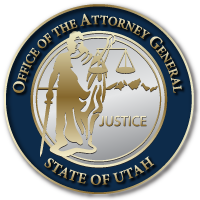Attorney General Sean D. Reyes has been a leader and an international voice in the fight against human trafficking and continues to lead Utah to aggressively fight through education campaigns, support of anti-human trafficking legislation, victim recovery, and advocacy. This is accomplished through grassroots and non-governmental organizations efforts, partnerships with local law enforcement officers and agencies, as well as work initiated by his office through the Utah Trafficking in Persons (UTIP) Task Force and prosecutors of the Utah SECURE Strike Force.
Defined: Human trafficking is a modern-day form of slavery involving the illegal trade of people for exploitation or commercial gain.
Every year, millions of men, women, and children are trafficked in countries around the world, including the United States. It is estimated that human trafficking is a $32 billion per year industry, second only to drug trafficking as the most profitable form of transnational crime.
Human trafficking is a hidden crime, as victims rarely come forward to seek help because of language barriers, fear of the traffickers, and/or fear of law enforcement.
Traffickers use force, fraud, or coercion to lure their victims and force them into labor or commercial sexual exploitation. They look for people who are vulnerable for a variety of reasons, including economic hardship, natural disasters, or political instability. The trauma can be so great that many may not identify themselves as victims or ask for help, even in highly public settings.
Trafficker tactics:
- Using violence or threatening the person or person’s family members;
- Harming or depriving the person of basic necessities, such as food, water, or sleep;
- Making false promises of love or companionship;
- Making false promises of a good job and home;
- Restricting contact with friends or family;
- Limiting freedom of movement;
- Controlling the person’s identification documents;
- Threatening deportation or law enforcement action; or
- Garnishing the person’s salary to pay off alleged debts.
INDICATORS
Recognizing key indicators of human trafficking is the first step in identifying victims and can help save a life. Not all indicators listed below are present in every human trafficking situation, and the presence or absence of any of the indicators is not necessarily proof of human trafficking. The safety of the public, as well as the victim, is paramount. Do not attempt to confront a suspected trafficker directly or alert a victim to any suspicions. It is up to law enforcement to investigate suspected cases of human trafficking.
- Does the person appear disconnected from family, friends, community organizations, or houses of worship?
- Has a child stopped attending school?
- Has the person had a sudden or dramatic change in behavior?
- Is a juvenile engaging in commercial sex acts?
- Is the person disoriented or confused or showing signs of mental or physical abuse?
- Does the person have bruises in various stages of healing?
- Is the person fearful, timid, or submissive?
- Is the person often in the company of someone to whom he or she defers? Or someone who seems to be in control of the situation, e.g., where they go or who they talk to?
- Does the person appear to be coached on what to say?
- Is the person living in unsuitable conditions?
- Does the person lack personal possessions and appear not to have a stable living situation?
- Does the person have freedom of movement? Can the person freely leave where they live?
Although human smuggling is very different from human trafficking, human smuggling can turn into trafficking if the smuggler uses force, fraud, or coercion to hold people against their will for the purposes of labor or sexual exploitation. Under federal law every minor induced to engage in commercial sex is a victim of human trafficking.
Myths and Misconceptions
Many misconceptions exist about human trafficking. For example, people think it only occurs abroad; that victims are only foreign-born or impoverished individuals; that traffickers are always strangers; and that victims always have visible chains.
Myth #1: Human trafficking does not occur in the United States. It only happens in other countries.
Fact: Human trafficking exists in every country, including the United States. It exists nationwide–in cities, suburbs, and rural towns–and probably in your own community.
Myth #2: Human trafficking victims are only foreign-born individuals and those who are poor.
Fact: Human trafficking victims can be any age, race, gender, or nationality: young children, teenagers, women, men, runaways, United States citizens, and foreign-born individuals.
Myth #3: Human trafficking is only sex trafficking.
Fact: You may have heard about sex trafficking, but forced labor is also a significant and prevalent type of human trafficking. Victims are found in legitimate and illegitimate labor industries, including sweatshops, massage parlors, agriculture, restaurants, hotels, and domestic service. Note that sex trafficking and forced labor are both forms of human trafficking, involving the exploitation of a person.
Myth #4: Individuals must be forced or coerced into commercial sex acts to be a victim of human trafficking.
Fact: According to U.S. federal law, any minor under the age of 18 who is induced to perform commercial sex acts is a victim of human trafficking, regardless of whether he or she is forced or coerced.
Myth #5: Human trafficking and human smuggling are the same.
Fact: Human trafficking is not the same as smuggling. “Trafficking” is exploitation-based and does not require movement across borders. “Smuggling” is movement-based and involves moving a person across a country’s border with that person’s consent, in violation of immigration laws.
Myth #6: All human trafficking victims attempt to seek help when in public.
Fact: Human trafficking is often a hidden crime. Victims may be afraid to come forward and get help; they may be forced or coerced through threats or violence; they may fear retribution from traffickers, including danger to their families; and they may not be in possession or have control of the identification documents.

